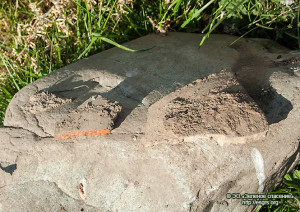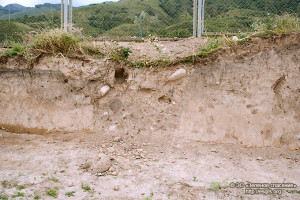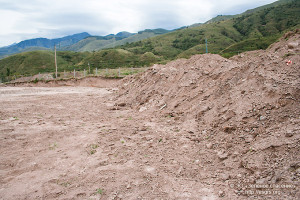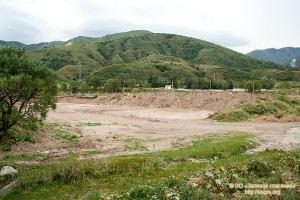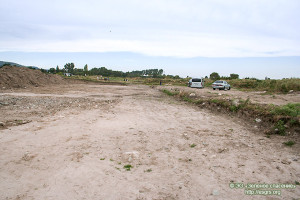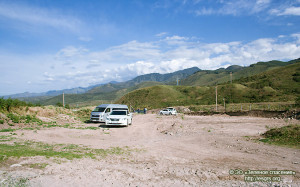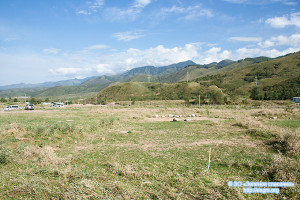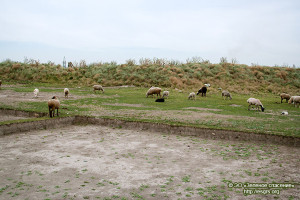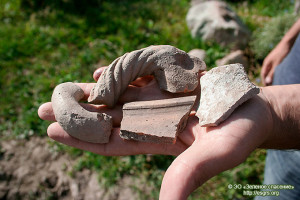
On September 2, the decision of the World Heritage Committee regarding Talgar site was published on the website of the Convention Concerning the Protection of the World Cultural and Natural Heritage.
This is not Europe
The 40th Session of the World Heritage Committee took place in Istanbul from July 10 to 20. One of the points on the Agenda was related to the question about failure of Kazakhstan to comply with the requirements of the Convention Concerning the Protection of the World Cultural and Natural Heritage. Country which in November 2013 was chosen to be — and presently is a part of — the World Heritage Committee, cannot provide safeguarding of its own monuments!
In 2014, China, Kazakhstan, and Kyrgyzstan completed preparation of a joint nomination “Great Silk Roads of Changa’an — Tianshan corridor” and presented it to the Word Heritage Committee. This is how specifically Talgar site of ancient settlement, located near the city of Almaty, was included into the UNESCO World Heritage List.
It seemed that nothing could spoil such happy news, but alas, as our officials like to say: “This is not Europe”.
On November 22, 2014, a delegation of Chinese historians and archeologists visited Talgar site. What did they see? No fencing, nor security guards. Private mansions are being constructed in the buffer (protection) zone. Markings for construction of an auto road to the mountain ski resort “Ak-Bulak” are made across the archeological monument. In a few meters from the site’s rampart, construction of a bridge across Talgar river is already being completed.
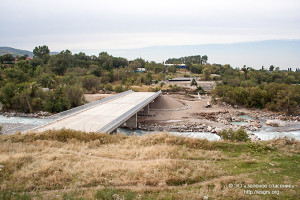
They warned us
A dossier of 2012, which was prepared for nomination of Talgar site into the World Heritage List, informed briefly and without details about construction of the above mentioned road. But it did not describe the construction as a potential threat to the site (1).
What came to the eyes of the Chinese delegation did not leave any doubts that in another month or two, the site of the World Heritage will be practically destroyed only so that mountain-skiers going to the resort could save 30 or 40 minutes of their invaluable time! What a truly statewide need! It was subsidized with the means from the republican and local budgets. According to the official information, construction and reconstruction of the auto road “Birlik-Almalyk-Ryskulov-Kazstroy-Ak-Bulak” will total up in 3.952 billion tenge (2).
Chinese experts who do not have connections in local government offices (akimats), ministries, or departments, understood everything right away and noted that the construction is conducted in violation of the Articles 18, 33, 35, 36 of the Law of the Republic of Kazakhstan “About Protection and Utilization of Sites of Historical and Cultural Heritage”. They indicated the contradictions between the land legislation and heritage legislation, pointed out a lack of proper coordination between the relevant state departments and branches of all levels. The delegates specifically highlighted a lack of awareness by the officials on “almost all levels” of what “World Heritage” is, what its legal status is, and what guarantees the protection of the WH properties by State Parties (3).
After that, there was a huge scandal. The construction was stopped, the officials promised to do everything according to the law, build the road bypassing the site of ancient settlement, provide protection of the monument.
Changes to the better or worse?

And in fact, something was done. But not a lot. In December 2014 and January 2015, expert groups visited the site with participation of representatives from the administration of the Almaty Oblast, concerned institutions and departments. A decision about suspension of further works was made and a statement was made about correction of the highway project. The site was fenced, but only from the east and south sides. A banner appeared with a description of the site of ancient settlement Talgar, explaining its historical role in the development of Semirechye. But the banner was full of grammatical errors.
On March 18, 2015, deputies of Majlis of the Parliament filed an inquiry to the General Prosecutor’s Office asking to clarify the situation around the Talgar site of ancient settlement, and conduct an inspection. On April 17, 2015, the General Prosecutor in his reply to the deputies, indicated that “at the present time, works are suspended in the highway construction right-of-way, archeological surveys are conducted with consequent approval of the conclusion in the Ministry of Culture and Sports” (4).
In summer 2015, archeological prospect holes appeared at the settlement which cut its rampart to the basement in two areas which impaired the integrity of the monument. All these actions were conducted under a plausible excuse of scientific research of the defense fortress.
In place of the corner tower destroyed during digging of the prospect-holes, our restaurateurs built a new wall out of cinder blocks (probably, with “ancient” origin). The wall was erected on concrete foundation and coated with cement, probably for durability. Local amateurs of antiquity also did not remain aloof of such outstanding “new development”. Very fast, they constructed houses right up against the north side of the ancient settlement. What a beauty, you come out to your balcony, and the world heritage site is right in front of your eyes!
In short, number of problems increased like a snowball.
Opinion of international experts
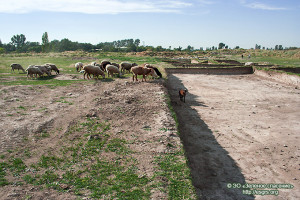
By an official request from the Republic of Kazakhstan, International Council on Monuments and Sites (ICOMOS) Advisory mission visited the country on March 21-23, 2016, in order to unravel this situation. One of its goals was to determine the influence of the road construction on the Outstanding Universal Value (OUV), integrity, and authenticity of Talgar site of ancient settlement (5).
A tribute should be paid to the ICOMOS experts, indeed, they dotted the i by identifying causes for this unsightly situation and its creators.
So, how did the experts explain such confusion, to put it mildly? Lack of coordination between different state organs at the countrywide and local levels.
Were there legal violations? Yes, there were violations of the national legislation and the Convention requirements.
But the Ministry of Culture and Sports had to provide control and management of the site? Monitoring was not conducted. World Heritage Sites Management System developed by the Convention was not applied.
How about the public, and its opinion? No public hearings about inclusion of the site of ancient settlement into the List were conducted in Talgar (6).
But, apparently, not only the public was unaware about what was happening on the site. In 2015, Kazakhstan presented a report about condition of monuments security in the country. Nothing was mentioned in the report about construction of the bridge and the road, development of the new houses in the protection zone of the site (7). But what was especially surprising to the ICOMOS representatives — the conclusions made on the basis of the excavations conducted by the LLP-archeologists. They stated that they “did not find proves of presence of a cultural archeological layer” (8).
Probably, shocked by what they saw and heard, the ICOMOS experts in their conclusions were categorical.
They recommended to immediately declare a moratorium over construction of the road to the mountain ski resort and develop an option which would not affect the settlement and its buffer zone, take a decision about dismounting of the bridge over Talgar river.
The mission indicated that it was necessary to:
— enhance control over compliance with the Law “About protection and utilization of sites of historical and cultural heritage” and bring it in accordance with the terminology and mechanisms of the Convention;
— enhance the mechanism of compliance of the Convention in the country;
— introduce amendments to the Land Code, in order to prevent destruction of monuments;
— urgently create an effective system for coordination between state organs of all levels;
— stop the reconstruction on the territory of the settlement which is not founded on comprehensive and detailed documentation. Present the project of reconstruction to the World Heritage Center;
— conduct archeological research using methods which do not destroy sites;
— announce a moratorium over construction in the buffer zone and review a question about removal of the new constructions;
— develop a general plan of the buffer zone, in order to stop individual construction and development. General plan shall be presented to the World Heritage Center (9).
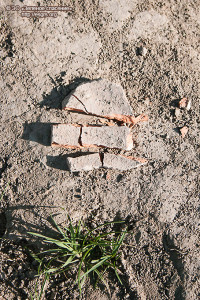
Spring-summer 2016
But the ICOMOS mission left, and spring came. Construction works, like Phoenix bird, revived after the withering report. Last year’s trash thawed out and piles of dirt of unknown origin appeared on the territory of the monument; as before, sheep is grazing on the site, the banner with the description of the site decayed and got teared to shreds! Again, dump trucks scurry about, construction machinery rumbles. LLP-archeologists conducted excavation works strictly along the route of the proposed road. They continue arguing that there is nothing valuable on the site of the world heritage, while the scientists — ours, Chinese, of the World Heritage Committee — do not know anything about archeology, nor about the World Heritage!
By August, the dumpings of fill dirt for the road bed reached the southeast end of the settlement, a huge pile of gravel was dumped on the settlement, probably, to continue the works. Fencing is broken in several places. The rampart was subjected to another “modernization”. Its bottom was trimmed by bulldozers, and dirt was dumped on its top.
Ecological Society “Green Salvation” addressed a court to receive comprehensive information about what was happening and to raise a question about factual inaction of the Ministry of Culture and Sports, but these attempts failed. All judicious instances refused to satisfy the lawsuit demands. It appeared that construction of the road, piles of dirt, destroyed rampart, torn banner with the description of the World Heritage site, rumbling machinery, grazing sheep, and private mansions in the buffer zone — all of that is legal!
Decision of the World Heritage Committee
The 40th session of the World Heritage Committee took place in Istanbul from July 10th to 20th. A decision about Kazakhstan’s compliance with the Convention requirements was adopted during a meeting on July 13th. The Committee agreed with the main conclusions of the ICOMOS mission:
— to stop immediately the road construction through the settlement, explore other routes outside the boundaries of the Talgar site and its buffer zone, and to dismantle the parts of the bridge that have already been constructed;
— to halt the construction works on the settlement which are conducted without a comprehensive study of the projects;
— to halt the residential development in the buffer zone and to provide full details of the project to the World Heritage Centre;
— the authorities to address the recommendations of the ICOMOS with regard to protection, management and awareness-raising and to take all necessary actions to ensure the safeguarding of the authenticity and integrity of the Talgar component site of the serial property;
— to invite, as soon as possible, a joint World Heritage Centre/ICOMOS Reactive Monitoring mission to the Talgar component site and other sites of the serial property in Kazakhstan, to consider the implementation of the recommendations of the Advisory mission and the progress accomplished with the development of management plans for all components sites in Kazakhstan;
— to submit to the World Heritage Centre, by 1 December 2017, a joint updated report on the state of conservation of the property and the implementation of the above, for examination by the World Heritage Committee at its 42nd session in 2018 (10).
It should be noted that in its report, the ICOMOS mission specifically reminded that according to the Article 1 of the Law of the Republic of Kazakhstan “About Protection and Utilization of Sites of Historical and Cultural Heritage”, “if an international agreement ratified by the Republic of Kazakhstan contains rules which differ from the ones contained in the present Law, the rules of the international agreement are applied.” In other words, the Convention has a priority over law of Kazakhstan (11).
Traditional questions: who is guilty and what is next?
The Law states that monuments of history and culture in the Republic of Kazakhstan are subjected to obligatory protection. Further, it is stated that on “behalf of the Republic of Kazakhstan, the proprietor powers on the monument of history and culture of international and countrywide level are executed by an authority, and historical and cultural monuments of local level — by the local authorities of oblasts, cities of countrywide level…” (12)
In the case with Talgar, everything looks backwards. The Ministry of Culture and Sports is doing everything to seem not to be involved in the above described events. But isn’t it the Ministry’s responsibility as a proprietor, to “undertake measures for safeguarding historical and cultural monuments” (13)?! All accusations fall on the local executive organs. But can the local executive organs afford having on-staff archeologists, restaurateurs, experts in world heritage, in order to conduct the most complex assessments, restoration works, drawing of archeological maps?! This is not covered in a typical structure of local executive organs (akimats), nor in a typical structure of departments of culture. Akimats’ budgets do not possess of means for restoration and safeguarding of world heritage sites.
In short, while the investigation of who is responsible for what is going on, our primitive market extremists are using the state money to destroy the national property, paying attention neither to the national legislation, nor the international conventions. As a result — millions of wasted public funds (14), thousands of ruined trees, disfigured site of the world heritage, spoiled international reputation, and additional budget expenses to “fix” the situation. And what is next? Will the strict decision of the World Heritage Committee stop them?
We demand to undertake effective measures for implementation of the decision of the World Heritage Committee. We believe that the Minister of Culture and Sports cannot realize the functions assigned to him and implement the governmental policy, therefore, we demands his resignation, in accordance with the Constitutional Law “About Government of the Republic of Kazakhstan” (15). As a reminder, the Criminal Code of the Republic of Kazakhstan forces responsibility for willful destruction of monuments: “Willful destruction or damage of monuments of history, culture, natural complexes, or objects taken under protection of the state,… shall be punished by deprivation of freedom for a term of from three up to seven years” (16).
* * *
1 Report on the ICOMOS Advisory Mission to Kazakhstan. The Talgar component (S 01-KZ-01) within the serial World Heritage property Silk Roads: the Routes Network of Chang’an-Tianshan Corridor (China, Kazakhstan, Kyrgyzstan) (C 1442). 20 to 28 March 2016, р.4: http://whc.unesco.org/en/list/1442/documents.
2 Управление пассажирского транспорта и автомобильных дорог Алматинской области. Отчет о проделанной работе за 1 квартал 2015 года: http://avtozholdary.zhetysu.gov.kz/pages/28/, (24.08.2016).
Report on the ICOMOS…, pр.18-19. «The concrete four-span bridge over the Talgar river almost built (89 m long) with the costs of 583.014 million Kazakhstani Tenge. General costs for the road construction is 11. 239 million US $ (the list of costs for the period of 2014-2016 presented)».
3 Report on the ICOMOS…, pр.12-13.
4 Ответ на депутатский запрос Генерального прокурора РК от 17 апреля 2015 года: http://www.zakon.kz/4706423-otvet-na-deputatskijj-zapros.html, (08.08.2016).
5 Report on the ICOMOS…, p.5. «On 6 October 2015, the authorities of the Republic of Kazakhstan requested an ICOMOS Advisory mission for Tamgaly and the Mausoleum of Khoja Ahmed Yasawi (Turkestan), and later added Talgar as well in order to clarify the impact of the construction of the Birlik-Almalyk-Kazstroy-Ryskulov-Ak-Bulak road on the property and its OUV».
6 Report on the ICOMOS…, p.19.
«The analysis of the sequence of events along this time-line, allows for the following brief observations:
-The evidence of un-coordination within different State departments and authorities, the lack of links between the National, Regional and Local executive bodies;
— The evidence of the violation of National law, as well as obligations related to the World Heritage Convention;
— The dysfunction of monitoring and management systems, elaborated for World Heritage properties, in practice;
— A misunderstanding of heritage values and conditions for their sustainability;
— A lack of adequate knowledge and understanding of the notion of ‘World Heritage’ and its framework practically on all administrative levels;
— A lack of public awareness; in Talgar there were no public hearings on the inscription of the ancient settlement onto the World Heritage List».
7 Report on the ICOMOS…, p.10.
«The State Party of Kazakhstan submitted a report on the state of conservation in 2015, answering some of these recommendations (section V of this Mission report). However, neither the road and bridge construction, nor the new cottages built in the near vicinity of the World Heritage property in the buffer zone, are mentioned in this report».
8 Report on the ICOMOS…, p.19. «However, the Mission was told that the results of this research presented no evidence of a cultural archaeological layer, which the mission considers rather surprising».
9 Report on the ICOMOS…, pp.26-29.
10 Decision : 40 COM 7B.34 Silk Roads: the Routes Network of Chang’an – Tian-shan Corridor (China / Kazakhstan / Kyrgyzstan) (C 1442): http://whc.unesco.org/en/decisions/6699/, (02.09.2016).
11 Report on the ICOMOS…, p.11.
12 Закон РК «Об охране и использовании объектов историко-культурного наследия» (с изменениями и дополнениями по состоянию на 29.03.2016 г.), статья 11.
13 Закон РК «Об охране и использовании объектов…», статья 13.
14 Управление пассажирского транспорта и автомобильных дорог Алматинской области. Отчет о проделанной работе за 1 квартал 2015 года: http://avtozholdary.zhetysu.gov.kz/pages/28/, (24.08.2016).
15 Конституционный закон РК от 18 декабря 1995 года №2688 «О Правительстве Республики Казахстан» (с изменениями и дополнениями по состоянию на 29.09.2014 г.), статья 5, пункт 1.
16 Уголовный кодекс РК (с изменениями и дополнениями по состоянию на 09.04.2016 г.), статья 203, пункт 1.


